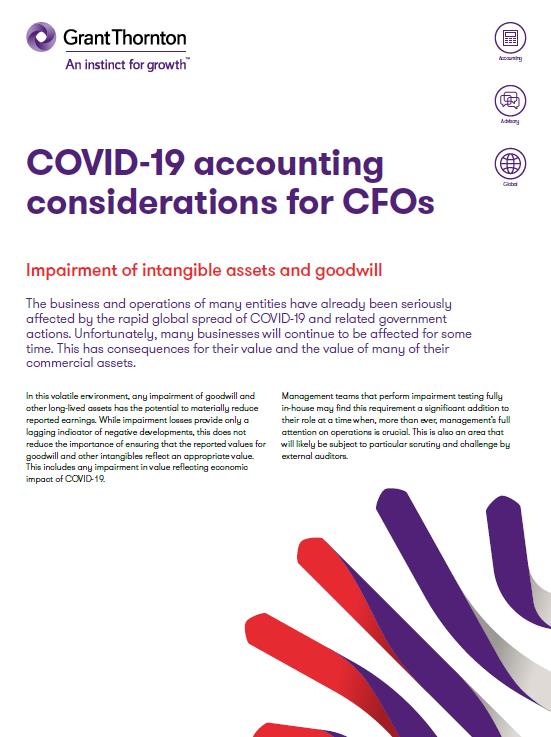-
Accounting Advisory
Our accounting advisory team help businesses meet their complex financial reporting requirements. The team can support in applying new financial reporting standards, IFRS/ US GAAP conversions, financial statement preparation, consolidation and more.
-
Payroll
Our team can handle your payroll processing needs to help you reduce cost and saves time so that you can focus on your core competencies
-
Managed accounting and bookkeeping
Outsourcing the financial reporting function is a growing trend among middle market and startup companies, as it provides a cost-effective way to improve the finance and accounting function. Our team can help with financial statement preparation, consolidation and technical on-call advisory.
-
Accounting Advisory
Our team helps companies keep up with changes to international and domestic financial reporting standards so that they have the right accounting policies and operating models to prevent unexpected surprises.
-
Crypto Accounting Advisory Service
Our team can help you explore appropriate accounting treatment for accounting for holdings in cryptocurrencies, issuance of cryptocurrencies and other crypto/blockchain related accounting issues.
-
ESG Reporting and Accounting
As part of our ESG and Sustainability Services, our team will work with you on various aspects of ESG accounting and ESG reporting so that your business can be pursue a sustainable future.
-
Expected Credit Loss
Our team of ECL modelling specialists combine help clients implement provisioning methodology and processes which are right for them.
-
Managed Accounting and Bookkeeping Services
Outsourcing the financial reporting function is a growing trend among middle market and startup companies, as it provides a cost-effective way to improve the finance and accounting function. Our team can help with financial statement preparation, consolidation and technical on-call advisory.
-
Business Tax Advisory
Our business tax team can help you navigate the international tax landscape, grow through mergers and acquisitions, or plan an exit strategy.
-
Corporate Finance
Our corporate finance team helps companies with capital raising, mergers and acquisitions, private equity, strategic joint ventures, special situations and more.
-
Financial Due Diligence
From exploring the strategic options available to businesses and shareholders through to advising and project managing the chosen solution, our team provide a truly integrated offering
-
Valuations
Our valuation specialists blend technical expertise with a pragmatic outlook to deliver support in financial reporting, transactions, restructuring, and disputes.

-
Sustainability with the ARC framework
Backed by the CTC Grant, businesses can tap on the ARC Framework to gain access to sustainability internally, transform business processes, redefine job roles for workers, and enhance productivity. Companies can leverage this grant to drive workforce and enterprise transformation.

-
Business Tax Advisory
Our business tax team can help you navigate the international tax landscape, grow through mergers and acquisitions, or plan an exit strategy.
-
Corporate Tax Compliance
Our corporate tax teams prepare corporate tax files and ruling requests, support you with deferrals, accounting procedures and realise tax benefits.
-
Tax Governance
Our Tax Governance Services are designed to assist organisations in establishing effective tax governance practices, enabling them to navigate the intricate tax environment with confidence.
-
Goods and Services Tax
Our GST team supports organisations throughout the entire business life-cycle. We can help with GST registration, compliance, risk management, scheme renewals, transaction advisory and more.
-
Transfer Pricing
Our Transfer Pricing team advises clients on their transfer pricing matters on and end-to-end basis right from the designing of policies, to assistance with annual compliance and assistance with defense against the claims of competing tax authorities.
-
Employer Solutions
Our Employer Solutions team helps businesses remain compliant in Singapore as well as globally as a result of their employees' movements. From running local payroll, to implementing a global equity reward scheme or even advising on the structure of employees’ cross-border travel.
-
Private Client Services
Our private client services team provides a comprehensive cross section of advisory services to high net worth individuals and corporate executives, allowing such individuals to concentrate on their business interests.
-
Welfare and benefits
We believe that a thriving team is one where each individual feels valued, fulfilled, and empowered to achieve their best. Our welfare and benefits aim to care for your wellbeing both professionally and personally.
-
Career development
We want to help our people learn and grow in the right direction. We seek to provide each individual with the right opportunities and support to enable them to achieve their best.
The business and operations of many entities have already been seriously affected by the rapid global spread of COVID-19 and related government actions. Unfortunately, many businesses will continue to be affected for some time. This has consequences for their value and the value of many of their commercial assets.
In this volatile environment, any impairment of goodwill and other long-lived assets has the potential to materially reduce reported earnings. While impairment losses provide only a lagging indicator of negative developments, this does not reduce the importance of ensuring that the reported values for goodwill and other intangibles reflect an appropriate value. This includes any impairment in value reflecting the economic impact of COVID-19.
Management teams that perform impairment testing fully in-house may find this requirement a significant addition to their role at a time when, more than ever, management’s full attention on operations is crucial. This is also an area that will likely be subject to particular scrutiny and challenge by external auditors.
Download impairment of intangible assets and goodwill [ 213 kb ] [ 267 kb ]
IAS 36 ‘Impairment of Assets’
IAS 36 seeks to ensure that the assets of a reporting entity are carried at amounts not in excess of their recoverable amounts.
IAS 36 defines the recoverable amount of an asset as the higher of its fair value less costs of disposal (FVLCD) to sell and its value in use (VIU). Fair value is defined as an amount obtainable in an arm’s length transaction between knowledgeable and willing parties. VIU is based on an estimate of the future cash flows the entity expects to derive from the use of an asset or associated cash generating unit (CGU) in its current form. COVID-19 is likely to impact both FVLCD and VIU.
If the carrying amount of an asset exceeds its recoverable amount the asset is impaired. IAS 36 then requires the entity to write down the asset to its recoverable amount and recognise an impairment loss.
IAS 36 requires that both intangible assets with an indefinite useful life (and any intangibles not yet ready for their intended use) and goodwill be tested for impairment at least annually. For other asset classes that fall under the standard, the entity is required to test the asset for impairment when indicators of impairment are present.
Below are some issues for management to consider in assessing impairment together with some direction as to how best to respond to them.
This will depend heavily on the reporting date for the entity. For those with a year-end of 31 December 2019 or earlier the answer is likely no because COVID-19 was not considered to be a significant issue for most economies and businesses on that date. However, the accounting standards do require disclosure about material non-adjusting events after the balance sheet date, including an estimate of the financial effects when possible. Those with a 31 March 2020 reporting date and onwards will clearly need to consider COVID-19 as an impairment indicator for financial reporting purposes.
Detailed examples of indicators of impairment are included in IAS 36.12. The most relevant indicators are included below – note that this list is not exhaustive. Given the prevalence of certain of these indicators, we encourage management to consider and document carefully the presence of these factors and the consequences they might have on their financial statements.
External indicators
• Observable indicators of decrease in value
• Significant changes with an adverse effect on the entity have taken place during the period in the economic environment in which the entity operates or in the market to which an asset is dedicated
• The carrying amount of the net assets of the entity is more than its market capitalisation.
Internal indicators
• Assets becoming idle
• Evidence that economic performance is worse than expected
• Plans to dispose of an asset
• Plans to restructure.
Long-lived assets are likely to be impacted. These include:
• right-of-use assets arising from lease contracts
• property, plant and equipment
• intangibles.
As mentioned, IAS 36 requires these assets to be tested for impairment where indicators of impairment are identified. This testing is performed for individual assets if they generate cash inflows largely independently. For other assets and goodwill, testing is mainly by reference to the CGU that the asset belongs to. In some cases it is possible to reliably estimate FVLCD at individual asset level but VIU only at CGU level. If the FVLCD estimate shows there is no impairment loss it is not necessary to test the CGU as well (IAS 36.22).
Entities may have assets that are subject to impairment testing that do not qualify as long-lived assets and are not financial assets. These assets should be assessed for impairment as they could be impacted by COVID-19, particularly where these amounts reflect historic transactions with third parties where the creditworthiness of these third parties is now called into question. For example, an entity might have prepaid for goods or services but the counterparty might no longer be able to provide these or refund the payment.
As a reminder, recoverable amount is the higher of VIU and FVLCD. COVID-19 will often affect both amounts. Many entities start by estimating VIU. This is because if VIU exceeds carrying value there is no need to determine FVLCD (and vice versa). However, if VIU indicates an impairment loss then FVLCD should also be estimated – unless facts and circumstances indicate that FVLCD would not be materially higher than VIU or it cannot be estimated reliably.
The main building blocks of the VIU estimate are cash flow projections, a risk-free discount rate and adjustments to incorporate variability, uncertainty and other factors that market participants would reflect in pricing the asset or CGU. These adjustments will also be affected by COVID-19. IAS 36 allows these adjustments to be reflected in one of two ways: by adjusting the discount rate or by adjusting the cash flows (including the long-term growth assumptions).
In normal times, the risk-adjusted discount rate approach is more typical. However, given the very high levels of current uncertainty, the risk-adjusted expected cash flow approach is often preferable as it involves more explicit consideration of the wider than normal range of possible future outcomes.
Whichever approach is used management must ensure the outcome reflects the risks, uncertainties and other factors that would influence market participants’ pricing decisions. It is equally important to ensure cash flow and discount rate concepts are aligned and so no double-counting of COVID-19 risks occurs.
It is likely to be far more challenging to determine a risk-adjusted discount rate in the current situation. The current volatility in financial markets introduces additional challenges to this process as the parameters used to estimate discount rates become more unpredictable. Values for assumptions which were somewhat settled in the past, such as the use of long-term government bond yields as a proxy for the risk-free rate, may no longer be appropriate. This means that, more than ever, discount rates need to be assessed after a thorough review of:
- current market conditions
- any guidance provided by market evidence of value for comparable reporting entities or assets
- the risks of the asset or CGU to be valued.
It is also likely, given the recent volatility of capital markets, that:
- beta for the entity may increase (as a result of increased risk related to forecasts given increased uncertainty); and
- the indicated cost of equity may increase.
Many entities are experiencing major disruption to their operations, with rapid declines in net cash flows and profits and ongoing uncertainty over duration and longer-term impact. The VIU cash forecasts must nonetheless reflect assumptions about these impacts based on facts and circumstances at the year-end. These assumptions should be explicit, clear and supportable. It is not reasonable, in the current environment, for most entities to base their estimates on performance in the comparative period – particularly if the reporting date is after 11 March 2020 when the World Health Organisation declared a global pandemic.
As the situation develops, more information about the severity of the financial impact may become available after year-end but before the date of approval of the financial statements. While the starting point is that entities are required to determine amounts based on their knowledge of events at the reporting date, not after it, information obtained after the reporting date can be considered if such conditions existed as of the reporting period end. Significant professional judgement of all relevant facts and circumstances will be required to make this assessment.
Entities with reporting dates after the outset of the COVID-19 pandemic are likely to have real challenges reflecting its impact in a single set of forecast cashflows due to very high levels of uncertainty. Companies should therefore consider developing multiple scenarios and applying probabilities to each to arrive at the expected cash flows. Reporting entities applying the risk-adjusted expected cash flow approach should give more weight to the downside scenario(s) to achieve the objective of incorporating a market view of risk and uncertainty.
When estimating FVLCD reference should be made to observable, arm’s length transactions as far as possible. Prices for fire-sales of assets or asset groups may not reflect an orderly transaction. In the current environment, it may be more difficult to determine a current fair value due to a lack of recent arms-length transactions between market participants as they are defined in IFRS 13 ‘Fair Value Measurement’.
In using a valuation technique to estimate FVLCD the inputs and assumptions should reflect only the information that would be available to market participants at the reporting date. Information not available at the reporting date (based on normal access and due diligence for a transaction involving the asset(s) in question) cannot affect fair value. When a fair value estimate uses unobservable inputs, management therefore needs to assess how information about COVID-19 available at the reporting date would influence market participants’ pricing decisions.
Detailed and explicit VIU cash flow forecasts are generally required to be for no more than five years. Beyond the detailed forecasting period IAS 36 requires an extrapolation using a steady or declining long-term growth rate. The impact of COVID-19 may mean that reporting entities will now be forced to use the asset in its current condition for a period extending well beyond five years, However, IAS 36 permits using a detailed forecast period of more than five years only if management cannot demonstrate an ability to forecast accurately over such a period. Conversely, long-term growth rate assumptions applied previously may no longer be suitable, particularly if the economic impact of COVID-19 is viewed as being more than short-lived.
Cash flow projections must also relate to the asset in its current condition. Also, many entities may restructure their operations as part of their response to COVID-19. This means management may need to demonstrate that any forecast improvements in the financial performance of an asset or CGU relate to the asset in its current condition and not to an enhancement or uncommitted future restructuring.
Indicators of impairment may appear as a result of the economic conditions caused by the spread of COVID-19 and an entity may be required to perform an impairment test, and record an impairment loss, during an interim period in 2020.
An entity may recognise an impairment loss in one period but, in a subsequent period, there may be an indication that the impairment loss recognised in the prior period may no longer exist or may have decreased. In such cases, IAS 36 states that an impairment loss recognised in prior periods for an asset other than goodwill should be reversed if, and only if, there has been a change in the estimates used to determine the asset’s recoverable amount since the last impairment loss was recognised. Impairment losses on goodwill cannot be reversed, even if the loss was recognised in an interim period and conditions have improved by year-end.
For example, consider a situation in which indicators of goodwill impairment are identified in the first quarter ended 31 March 2020 (Q1-2020) so the entity performs an additional test and recognises an impairment loss in Q1-2020. In Q4-2020, the entity performs its annual goodwill impairment test. This test shows that conditions have improved since Q1-2020 and that some or all of the impairment loss arising in Q1-2020 would not have been recognised based on this latest estimate.
In Q4-2020, can the entity reverse part, or all, of the goodwill impairment loss recognised in Q1-2020? The answer is no because of the explicit prohibition in IAS 36.
This prohibition seems to contradict a principle in IAS 34 ‘Interim Financial Reporting’ that ‘the frequency of an entity’s reporting (annual, half-yearly, or quarterly) shall not affect the measurement of its annual results. However, this contradiction was identified by the IFRS Interpretations Committee which published an interpretation (IFRIC 10) confirming that an impairment loss recognised for goodwill in an interim period cannot be reversed in a subsequent period.
The simple answer to this question is no. Some assets have been specifically excluded from the scope of IAS 36, otherwise IAS 36 should be applied. There are other standards that should be considered for those areas that have been excluded from its scope.
| Asset | In scope | Out of scope | If out of scope, the applicable IFRS |
| Inventories | X | IAS 2 | |
| Contract assets and assets arising from costs to obtain or fulfil a contract that are recognised in accordance with IFRS 15 Revenue from Contracts with Customers | X | IFRS 15 | |
| Assets not ready for use | X | ||
| Deferred tax assets | X | IAS 12 | |
| Assets arising from employee benefits | X | IAS 19 | |
| Financial assets within the scope of IFRS 9 | X | IFRS 9 | |
| Financial assets classified as subsidiaries (as defined by IFRS 10), associates (as defined by IAS 28), and joint ventures (as defined in IFRS 11) accounted for under the cost method for purposes of preparing the parent’s separate financial statements | X | ||
| Investment property (measured using the fair value method) | X | IAS 40 | |
| Investment property (measured at cost) | X | ||
| Biological assets (measured at fair value less costs of disposal) | X | IAS 41 | |
| Contracts within the scope of IFRS 17 Insurance Contracts that are assets | X | IFRS 17 | |
| Non‑current assets (or disposal groups) classified as held for sale in accordance with IFRS 5 Non‑current Assets Held for Sale and Discontinued Operations. |
X | IFRS 5 |
Impairments can be complex; a number of standards need to be considered before final conclusions are made and sometimes valuation specialists may need to be involved. Finally, do not leave assessments to the last minute, they can be time-consuming to prepare and then subsequently evaluate. It’s clear that regulators around the world are wanting more disclosure than less on impairments stemming from the COVID-19 pandemic.
How can Grant Thornton help?
Preparers of financial statements will need to be agile and responsive as the situation unfolds. Having access to experts, insights and accurate information as quickly as possible is critical – but your resources may be stretched at this time. We can support you as you navigate through accounting for the impacts of COVID-19 on your business.
Grant Thornton valuation experts provide time critical independent support and advice to organisations who must review or quantify any impairment risks relating to intangible assets and goodwill caused by the impact of COVID-19. Now more than ever the need for businesses, their auditor and any other accounting advisors to work closely together is essential.
If you would like to discuss any of the points raised, please speak to expert Chetan Hans.



